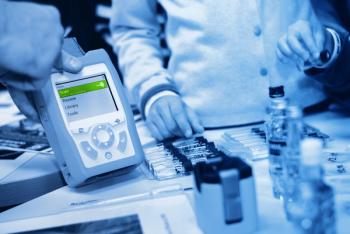
- Special Issues-09-01-2016
- Volume 31
- Issue 9
Analysis for Lead in Laundered Shop Towels Using Handheld X-ray Fluorescence Spectroscopy
Many automotive shops use a laundry service to clean their soiled shop towels. Previous studies have shown the towels can retain metals even after laundering and long-term exposure to certain metals such as lead could potentially result in health issues to employees using the towels. Laundered shop towels were collected from local automotive shops and analyzed to assess the ability of X-ray fluorescence (XRF) spectroscopy using a handheld system to measure harmful metal contaminants such as lead in the towels.
Many automotive shops use a laundry service to clean their soiled shop towels. Previous studies have shown the towels can retain metals even after laundering, and long-term exposure to certain metals, such as lead, could potentially result in health issues to employees using the towels. Laundered shop towels were collected from local automotive shops and analyzed to assess the ability of X-ray fluorescence (XRF) spectroscopy using a handheld system to measure harmful metal contaminants, such as lead, in the towels.
Reusable shop towels are a common practice in the automotive industry. The automotive shops typically use a laundry service to clean their soiled towels. This commonly used article can pose an unknown health hazard. Previous studies have shown that towels can retain metals even after laundering. Long-term exposure to certain metals, such as lead, can potentially result in health issues to employees using the towels. Laundered shop towels were collected from local automotive shops and analyzed to assess the ability of a portable handheld X-ray fluorescence (XRF) instrument to measure harmful contaminants, such as lead, in the towels. The handheld XRF proved to be a valuable tool because of its portability, speed, ease of use, and nondestructive nature.
Experimental
For this study, 45 laundered shop towels were collected from 16 local automotive shops in the Atlanta, Georgia, area. New unused Utopia auto shop towels were purchased through Amazon for control purposes. The samples were analyzed using a Thermo Scientific Niton XL3t 970 GOLDD+ handheld XRF analyzer for 60 s. The Consumer Goods internal calibration model that was provided with the spectrometer was used for quantitative purposes. The towels were folded lengthwise and then tightly rolled into a tube and analyzed in three locations. The same towels were then reverse rolled to change the exposed surface of the towel and were analyzed three more times for a total of six data points per towel. The reported results are an average of the six data points. Selective samples were also analyzed by inductively coupled plasma-optical emission spectrometry (ICP-OES) at ProQuality Labs in Cartersville, Georgia, to verify the results obtained with the handheld XRF analyzer.
Results and Discussion
Reusable shop towels are a staple item in the automotive service industry and other machinery-focused manufacturing and repair businesses. Shop towels (durable cloth wipers) are commonly used to spread cleaners and absorb or remove oil, grease, and dirt. They are routinely used for a wide variety of applications including wiping engine or mechanical parts and for cleaning work surfaces. These types of industries commonly use a laundry service to clean their soiled shop towels. The laundering process can take shop towels from several different locations and industries and combine them to wash the towels in bulk. The towels are then randomly redistributed back to their customers. If all the dirt and grime is not removed during the cleaning process, the residual contaminants from one industry can then end up on a laundered shop towel used by workers in a different industry. In addition to the random redistribution of the towels, there is also the possibility that as the towels are washed a portion of the dirt and grime is released and redeposited, cross-contaminating the laundered towels. In either case, commingling the shop towels from several different locations and industries in the laundering process may result in hazardous heavy metals in one industry coming in contact with workers in another industry.
Although the ubiquitous red shop towel is a staple item in automotive shops, very little research has been done to characterize the trace metals in the towels. A couple of studies have investigated the hazards of using shop towels (1–3). The first two studies focused their efforts on estimating the oral intake of heavy metals from using the towels and the potential long-term exposure risks associated with using the towels. The third study measured the concentration of metals in synthetic sweat leachate from laundered shop towels. These measurements were used to do a risk assessment for the transfer of lead and other metals from the towels to the users.
The objective of this study was to better understand the scope of heavy metal contamination in laundered shop towels that are used in the automotive industry using a portable handheld XRF analyzer. The handheld XRF analyzer was chosen for this study for its portability, ease of use, and ability to rapidly analyze several samples with nominal sample preparation. The concept of using a handheld XRF spectrometer for this study was taken with some skepticism because of the porous nature of the shop towels. A denser substrate is typically desired because it provides a better signal from the sample, resulting in lower detection limits and better reproducibility. Consequently, selective samples were also analyzed by ICP-OES to determine if the results obtained by the handheld XRF were acceptable.
The laundered towels were collected from the 16 automotive shops, and although the towels had been “cleaned” they were stained, contained metal and polymer fragments, and had a petroleum odor. Initial analysis of the towels identified nine metals at levels over 50 ppm including Ba, Fe, Sb, Cr, Ni, Ti, Cu, Pb, and Zn. Of these, lead, copper, and antimony were above what was reported to be a safe threshold limit based on previously published data (1,2). These previous studies concluded that lead posed the highest risk to an employee’s health because even at low concentrations in the blood it has been associated with impaired kidney function, high blood pressure, nervous system and neurobehavioral effects, and cognitive dysfunction later in life that might be caused by long-term, low-level exposure like that encountered with routine use of laundered shop towels (2). The majority of the antimony that was detected in the laundered shop towels most likely came from the fibers used in the construction of the shop towels and was not from residual dirt and grime from prior use. Several of the laundered and new shop towels were analyzed by Fourier transform infrared (FT-IR) spectroscopy. These results confirmed the towels were a blend of cotton and polyester fibers. Antimony is commonly used as a catalyst in the production of polyester terephthalate and is the likely source of the antimony detected by the handheld XRF spectrometer. The source of the copper was attributed to the general use of the shop towels and likely represents residual metal particles in the towel because of use.
Figure 1 shows the XRF results for lead from the 48 towels that were analyzed. All of the laundered towels tested, except two, contained a detectable amount of lead. The amount of lead in the laundered towels ranged from nondetectable to in excess of 70 ppm. Coincidently, the two towels that did not test positive for any lead came from the same automobile repair shop. All the towels from that particular location had significantly less lead than the towels from the other automotive shops and both towels looked relatively new. These two towels were not as threadbare as the towels obtained from the other repair shops. The new unlaundered shop towels and the unused disposable Wypall towels were also lead free. While inorganic lead does not readily enter the body through the skin, it can enter the body through accidental ingestion (eating, drinking, and smoking) via contaminated hands, clothing, and surfaces through hand to mouth transfer. Consequently, automotive mechanics and other people using similar laundered shop towels may inadvertently subject themselves to long-term exposure risks associated with lead and other heavy metals by using laundered shop towels (1).
Figure 1: XRF data for lead from laundered automotive shop towels. Codes A–P = clean laundered shop towels from different automotive shops; Q = unused, nonlaundered shop towels; R = unused disposable Wypall shop towels; numbers = individual shop towels from respective automotive shops.
The XRF data suggest that the lead contamination in the laundered shop towels is a ubiquitous contaminant and not shop dependent. A potential source of the contamination could be cross-contamination during the laundering process. To verify this, lead-contaminated towels were washed with new unused shop towels. Towels were impregnated with lead and lead oxide using a Mini Martindale abrasion and pilling tester. Approximately 0.1 g of lead was rubbed into the towels using a random pattern and a cycle time of 50 with a 9-kPa pressure. Six towels containing the lead were washed with six new towels and six bath towels, which were used for bulk. An industrial laundry detergent that is designed to lift and suspend a wide range of metal particles, dirt, grease, and grime was used to clean the towels. The laundered towels were allowed to air dry before analysis. Approximately 90% of the lead was removed from the contaminated towels by the laundering process. This implies that a significant amount of the lead particles was retained within the towels even after laundering. This lead retention was also evidenced by the discoloration of the towels after laundering. Lead analysis of the unused laundered towels were found to contain 130–250 ppm of lead. Based on the levels of lead detected in the unused laundered towels, it is likely that more lead was used for this study than what is commonly transferred to the towel during routine use. The data do, however, suggest that lead particles can transfer during the wash cycle, that not all the lead may be removed during washing, and that cross contamination of heavy metals can occur during the laundering process.
To verify that the results obtained with the handheld XRF analyzer were consistent with a primary technique commonly used for metals analysis, selective towels were analyzed by ICP-OES. These results are summarized in Figure 2. Although the lead concentrations that were obtained with the handheld XRF analyzer are slightly, but consistently, overrepresented in the towels, the lead data obtained with the handheld XRF spectrometer were representative of the sample sets.
Figure 2: Comparison study of lead in laundered automotive shop towels using handheld XRF and ICP-OES.
Conclusions
Lead was consistently detected on laundered shop towels from several different automotive shops using a handheld XRF spectrometer. The handheld XRF spectrometer provided the ability to accurately assess the lead concentration in the laundered shop towels. The handheld XRF spectrometer also provided the ability to analyze several samples very quickly with little or no sample preparation and without destroying the sample. The presence of heavy metals in reusable shop towels is likely caused by residual material left behind even after the towels are laundered. The data also suggest that the contaminants can transfer between the towels as they are washed.
It should be noted that laundered shop towels have been used for decades and have likely always contained heavy metal contaminants. Furthermore, there have been no reported adverse effects associated with using laundered shop towels (3). The data, however, confirm that heavy metals are present in the towels and the metal contaminates are not fully removed and can transfer to other towels during the laundering process. This lingering metal contamination could create the potential for unknown long-term exposure risks for workers using laundered shop towels.
References
- L. Beyer, M. Seeley, and B. Beck, INJ. Winter, 23–36 (2003).
- L. Beyer, G. Greeberg, and B. Beck, Hum. Ecol. Risk Assess.20, 111–136 (2013).
- K. Connor and B. Magee, Regul. Toxicol. Pharmacol.70, 125–137 (2014).
Kyle W. Scott is a product engineer with Kimberly-Clark Corporation in Neenah, Wisconsin. Wade R. Thompson is the Technical Leader with Kimberly-Clark Corporation in Roswell, Georgia.
Direct correspondence to: wrt@kcc.com
Articles in this issue
Newsletter
Get essential updates on the latest spectroscopy technologies, regulatory standards, and best practices—subscribe today to Spectroscopy.





